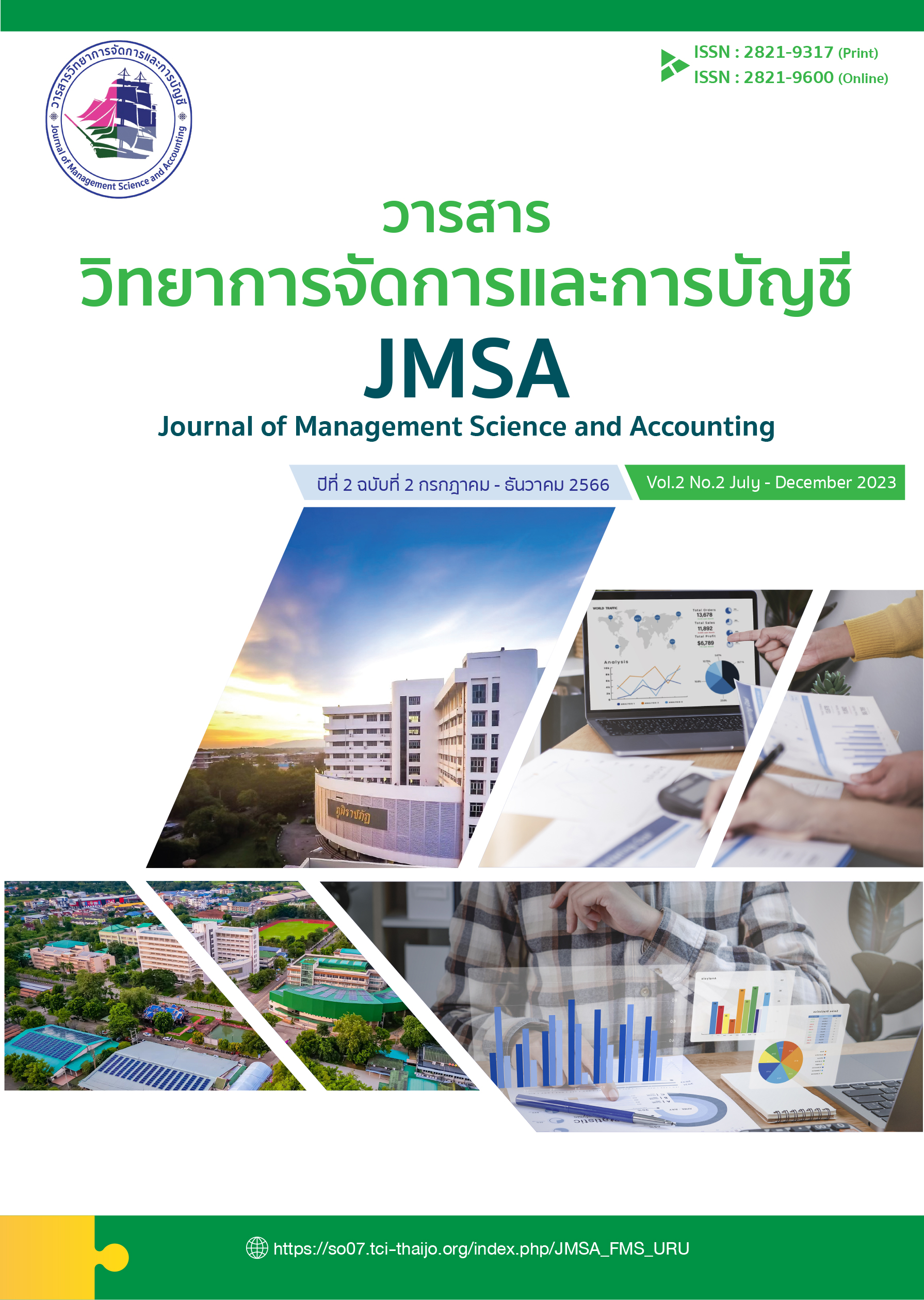5-Star Hotel Business Management Model in Hua Hin District, Prachuap Khiri Khan Province After the Covid-19 Pandemic
Main Article Content
Abstract
The research study entitled “the tourism model of 5-star hotel operators in Hua Hin, Prachuap Khiri Khan province” aims to investigate (1) the tourism model and the exploratory factor analysis of tourism success of 5-star hotel operators after the COVID-19 pandemic in Hua Hin District, PrachuapkhiriKhan Province, and (2) guidelines to develop tourism patterns of Hua Hin District, Prachuapkhiri Khan Province. This research employed a mix-method design using a questionnaire to collect quantitative data from 386 five-star hotel guests, together with documentation and in-depth interviews for qualitative data from key informants including 6 hotel executives in Hua Hin District, Prachuapkhiri Khan Province. The qualitative data were analyzed and discussed through content analysis.
The quantitative results showed that Kaiser-Meyer-Olkin (KMO) was 0.703 and Chi-Square (2) was 13692.904. The findings revealed 5 elements, all of which had a range of values of Eigenvalue between 1.250–8.279 and had cumulative variance of 51.74 percent. The 5 elements found were 1) attractions, 2) accessibility, 3) amenities, 4) hiligth activities, and 5) accommodation. The qualitative revealed that the hotels had meetings to discuss ways to improve their service in order attract more tourists to return after the COVID-19, provided trainings for employees to increase safety measures after the COVID-19, studied the employees’ attitudes and potential towards their current work, provided more facilities to attract tourists, and sought for additional income. Thus, the qualitative and quantitative results were in congruence, placing an emphasis in improving and creating attrations, accessability, facilities, highlighted activities, and the hotel environment and conditions that is encouraging for both relaxation and recreation at the same time.
Article Details

This work is licensed under a Creative Commons Attribution-NonCommercial-NoDerivatives 4.0 International License.
Articles published in the Journal of Management Science and Accounting Uttaradit Rajabhat University It is the copyright of Uttaradit Rajabhat University.
Articles published in Journal of Management Science and Accounting Uttaradit Rajabhat University Considered to be the personal opinion of the writer. The editorial board does not have to agree. Authors are responsible for their own articles.
Authors who publish agree to the following terms:
- Authors retain copyright and grant the journal right of first publication with the work simultaneously licensed under a Attribution-NonCommercial-NoDerivatives 4.0 International (CC BY-NC-ND 4.0) that allows others to share the work with an acknowledgment of the work's authorship and initial publication in this journal.
- Authors are able to enter into separate, additional contractual arrangements for the non-exclusive distribution of the journal's published version of the work (e.g., post it to an institutional repository or publish it in a book), with an acknowledgment of its initial publication in this journal.
- Authors are permitted and encouraged to post their work online (e.g., in institutional repositories or on their website) prior to and during the submission process, as it can lead to productive exchanges, as well as earlier and greater citation of published work.
References
การท่องเที่ยวแห่งประเทศไทย. (2557). สถิตินักท่องเที่ยวที่ได้เดินทางมาท่องเที่ยวที่อําเภอหัวหิน จังหวัดประจวบคีรีขันธ์. ประจวบคีรีขันธ์. การท่องเที่ยวแห่งประเทศไทย.
กองเศรษฐกิจการท่องเที่ยวและกีฬา. (2563). สถานการณ์ด้านการท่องเที่ยวไทย. (มปท.). กระทรวงการท่องเทียวและกีฬา.
เฉลิมพล ศรีทอง และธีรพงษ์ เที่ยงสมพงษ์. (2564). แนวทางการพัฒนาการท่องเที่ยวเมืองมรดกโลก และเมืองสร้างสรรค์โลก โดยชุมชนเมืองเก่าสุโขทัย สำหรับฐานวิถีชีวิตใหม่หลังสถานการณ์โควิด 19. วารสารมนุษยศาสตร์และสังคมศาสตร์ มหาวิทยาลัยธนบุรี, 15(2), 103-114.
บริสุทธิ์ แสนคำ. (2564). พฤติกรรมท่องเที่ยวของนักท่องเที่ยวชาวไทยหลังสถานการณ์โควิด 19. วารสารศิลปศาสตร์และอุตสาหกรรมบริการ, 4(1), 160-167.
ศิริเพ็ญ ดาบเพชร. (2561). องค์ประกอบการท่องเที่ยวและช่องทางการสื่อสารภาพลักษณ์การท่องเที่ยวสำหรับกลุ่มนักท่องเที่ยวอนาคต กรณีศึกษาจังหวัดพิษณุโลก. วารสารการวิจัยเพื่อพัฒนาชุมชน (มนุษยศาสตร์และสังคมศาสตร์). 11(1), 79-98.
สมบูรณ์ สุริยวงศ์,บุญมี พันธุ์ไทย, เตือนใจ เกตุษา, สุรศักดิ์ อมรรัตนศักดิ์, สมจิตรา เรืองศรี และ เพ็ญศรี เศรษฐวงศ์. (2552). Educational Research and Statistics: วิจัยและสถิติทางการศึกษา. พิมพ์ครั้งที่ 3. กรุงเทพฯ : สำนักพิมพ์ศูนย์ส่งเสริมวิชาการ.
สำนักงานปลัดกระทรวงการท่องเที่ยวและกีฬา. (2563). Covid -19 กับผลกระทบต่อการท่องเที่ยวไทย สถานการณ์การท่องเที่ยวของประเทศไทย ไตรมาส 1/2563. กรุงเทพฯ : สำนักงานฯ.
สุภมาส อังศุโชติ, สมถวิล วิจิตรวรรณา และรัชนีกูล ภิญโญภานุวัฒน์. (2552). สถิติวิเคราะห์สำหรับการวิจัยทางสังคมศาสตร์และพฤติกรรมศาสตร์:เทคนิคการใช้โปรแกรม LISREL. (พิมพ์ครั้งที่ 3). กรุงเทพฯ : เจริญดีมั่นคงการพิมพ์.
อุบลวรรณ สุวรรณภูสิทธิ์ และอำพล ชะโยมชัย. (2556). อิทธิพลของการสื่อสารการตลาดแบบบูรณาการที่มีต่อการตัดสินใจท่องเที่ยวเชิงประสบการณ์ของนักท่องเที่ยวไทย. วารสารวิทยาการจัดการและการบัญชี. 2(1), 1-17.
Aaker, D. A., Kumar, V., and Day, G. S. (2001). Marketing Research. John Wiley and Son.
Cochran, W.G. (1953). Sampling Techniques. New York : John Wiley & Sons, Inc.
Likert, R.. (1967). The Method of Constructing and Attitude Scale. In Reading in Fishbeic, M (Ed.), Attitude Theory and Measurement (pp. 90-95). New York : Wiley & Son.
Loureiro, S. M. C., & Gonzalex, F. J. M. (2008). The importance of quality, satisfaction, trust, and image in relation to rural tourism loyalty. Journal of Travel & Tourism Marketing. 25(2), 117-136.
Nunnally, J. C. & Bernstein, I. H. (1994). Psychometric Theory. (3rded.). McGraw-Hill.
Xiang, Z., & Gretzel, U. (2010). Role of social mediain online travel information search. Tourism Management, 31(2), 179-188.

